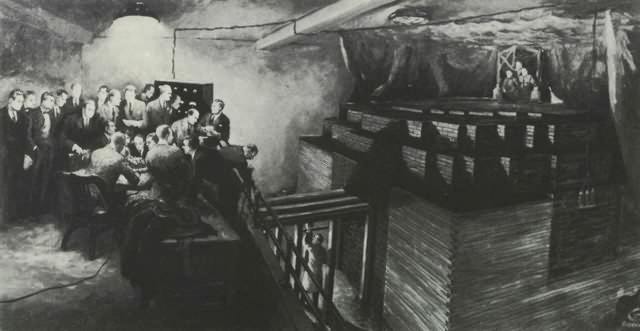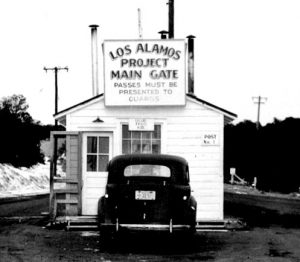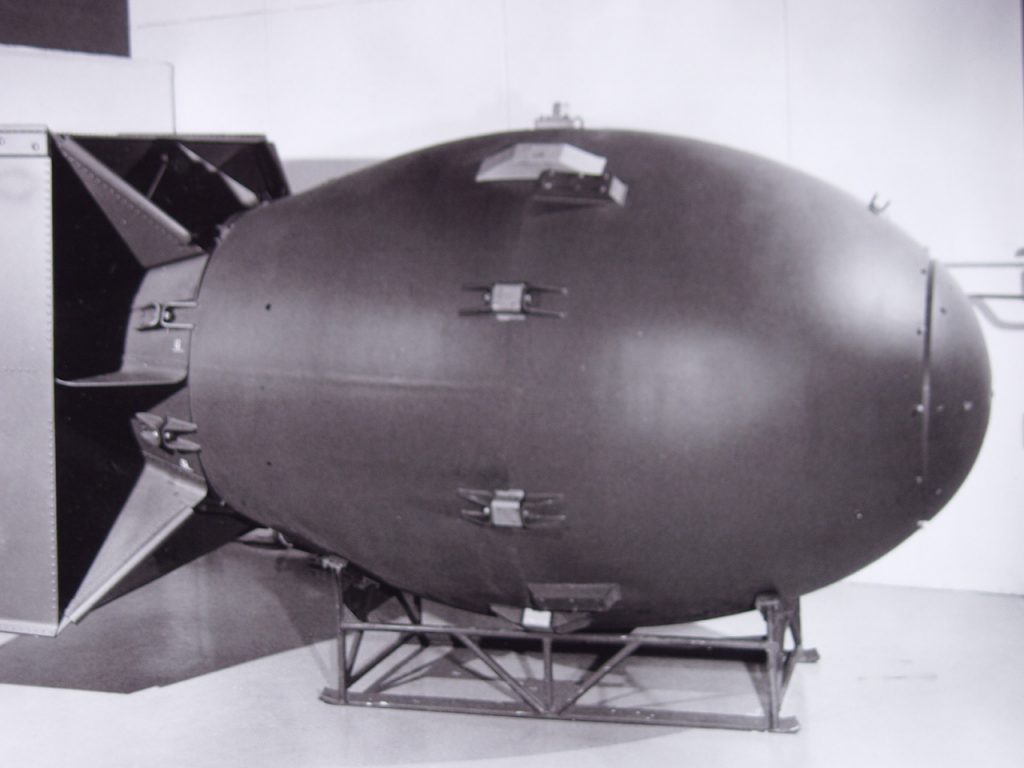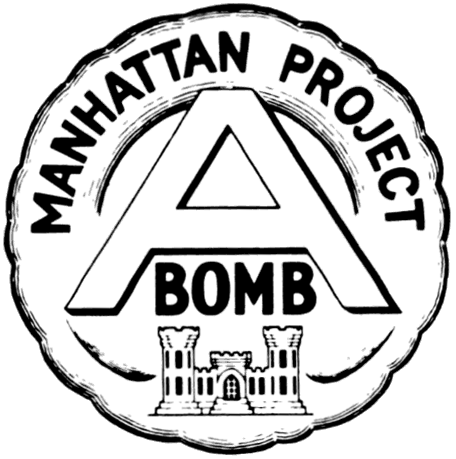The Manhattan Project was the result of an enormous collaborative effort between the U.S. government and the industrial and scientific sectors during World War II. Here is a brief summary of the Anglo-American effort to develop an atomic bomb during its World War II and its legacies today.
Preliminary Organization
The story of the Manhattan Project began in 1938, when German scientists Otto Hahn and Fritz Strassmann inadvertently discovered nuclear fission. A few months later, Albert Einstein and Leo Szilard sent a letter to President Roosevelt warning him that Germany might try to build an atomic bomb. In response, FDR formed the Uranium Committee, a group of top military and scientific experts to determine the feasibility of a nuclear chain reaction.
Nevertheless, initial research moved slowly until the spring of 1941, when the MAUD Committee (essentially the British equivalent to the Uranium Committee) issued a report affirming that an atomic bomb was possible and urging cooperation with the United States. The U.S. government responded by reorganizing its atomic research under the S-1 Committee, which was in turn under the jurisdiction of the newly created Office of Scientific Research and Development, led by Vannevar Bush. As the project progressed from research to development, however, Bush realized that the S-1 Committee did not have the resources for full-scale construction, eventually opting to turn to the Army for support.
Preliminary Research
 Prior to the formal creation of the Manhattan Project, atomic research was ongoing at a number of universities around the United States. At the “Rad Lab” (Radiation Laboratory) at the University of California at Berkeley, research was underway under the direction of Ernest Lawrence. Lawrence’s most significant discovery came with his invention of the cyclotron, known as an “atom smasher,” which could accelerate atoms through a vacuum and use electromagnets to induce collisions at speeds up to 25,000 miles per second. Lawrence believed his machine could separate Uranium-235 by electromagnetic separation, one of the four possible uranium isotope separation methods that would ultimately be considered during the Manhattan Project. Also during this time, Berkeley professors Emilio Segrè and Glenn Seaborg proved that the element 94, which they named plutonium, could also be used in nuclear reactions, offering another possible path to the bomb.
Prior to the formal creation of the Manhattan Project, atomic research was ongoing at a number of universities around the United States. At the “Rad Lab” (Radiation Laboratory) at the University of California at Berkeley, research was underway under the direction of Ernest Lawrence. Lawrence’s most significant discovery came with his invention of the cyclotron, known as an “atom smasher,” which could accelerate atoms through a vacuum and use electromagnets to induce collisions at speeds up to 25,000 miles per second. Lawrence believed his machine could separate Uranium-235 by electromagnetic separation, one of the four possible uranium isotope separation methods that would ultimately be considered during the Manhattan Project. Also during this time, Berkeley professors Emilio Segrè and Glenn Seaborg proved that the element 94, which they named plutonium, could also be used in nuclear reactions, offering another possible path to the bomb.
Meanwhile, at Columbia University, a team of scientists, including Enrico Fermi, Leo Szilard, Walter Zinn, and Herbert Anderson, conducted experiments using chain-reacting nuclear “piles” to measure the neutron emission from fission. Production was moved to the Metallurgical Laboratory at the University of Chicago in February 1942. On December 2, Chicago Pile-1 went critical, creating the world’s first self-sustaining chain reaction. The experiment not only proved that nuclear energy could generate power, but also showed a viable method to produce plutonium.
Forming the Manhattan Project
The Manhattan Project was officially created on August 13, 1942. The name itself, “Manhattan Project,” is commonly thought to be a misnomer, but its first offices were actually in Manhattan, at 270 Broadway. General Leslie R. Groves, who was appointed to head the project, decided to follow the custom of naming Corps of Engineers districts for the city in which they are located. The atomic bomb project thus became known as the Manhattan Engineer District (MED), or Manhattan Project for short.
Its first major funding came in December, when President Roosevelt ordered an initial allotment of $500 million. The headquarters of the project would soon be moved to Washington, D.C., while numerous project sites were scattered across the country.
Project Sites

The Manhattan Project’s weapons research laboratory was located at Los Alamos, New Mexico. Under the direction of J. Robert Oppenheimer, the Los Alamos laboratory would conduct the bulk of the remaining research and construction of the bomb. Physicists, chemists, metallurgists, explosive experts, and military personnel converged in the secret town, which grew to be the home of thousands of project workers. Meanwhile, the Army was charged with supplying, supporting, and guarding the top-secret work being done at Los Alamos.
Another important Manhattan Project site was located at Oak Ridge, Tennessee. By this time, the Manhattan Project was pursuing both a uranium and a plutonium based atomic bomb. Oak Ridge was thus the home of the uranium enrichment plants, K-25, Y-12, and S-50, and the pilot plutonium production reactor, the X-10 Graphite Reactor. Equally important was the site at Hanford, Washington, where the full-scale plutonium production plant, the B Reactor, was constructed, and was eventually joined by other reactors.
Dozens of other sites were also involved with the Manhattan Project. In Cambridge, Massachusetts, scientists conducted further research at Harvard University and the Massachusetts Institute of Technology. In Dayton, Ohio, the Manhattan Project tasked the Monsanto Chemical Company with separating and purifying the radioactive element polonium (Po-210), which was to be used as the initiator for the atomic bombs. Even in Canada, the Manhattan Project coordinated its efforts with the Montreal Laboratory and the Chalk River Nuclear Laboratories in Ontario, the site for one of the world’s first heavy water nuclear reactors. Meanwhile, the 509th Composite Group of the Army Air Forces, which would drop the atomic bombs on Japan, trained at Wendover Airfield in Utah and in Cuba before shipping out to the launching point for the atomic bomb attacks at Tinian Island in the Pacific.
It is estimated that more than 600,000 people worked on the project. For a list of more Manhattan Project sites, please click here.
Producing Results
 As the Manhattan Project grew closer to producing a bomb, the U.S. government began to consider its wartime options. In May 1945, Secretary of War Henry L. Stimson, with the approval of President Harry Truman, established the Interim Committee to make recommendations on wartime use of the bomb and post-war organization of atomic energy. The committee’s Scientific Panel would issue a report on June 16 recommending the use of the bomb against Japan.
As the Manhattan Project grew closer to producing a bomb, the U.S. government began to consider its wartime options. In May 1945, Secretary of War Henry L. Stimson, with the approval of President Harry Truman, established the Interim Committee to make recommendations on wartime use of the bomb and post-war organization of atomic energy. The committee’s Scientific Panel would issue a report on June 16 recommending the use of the bomb against Japan.
On July 16, the atomic age officially began when the world’s first atomic bomb was tested at the Trinity site in the New Mexico desert. The “Gadget” plutonium bomb exploded with approximately 20 kilotons of force and produced a mushroom cloud that rose eight miles high and left a crater that was ten feet deep and over 1,000 feet wide.
On August 6, the United States dropped its first atomic bomb on Hiroshima. Known as “Little Boy,” the uranium gun-type bomb exploded with about thirteen kilotons of force. The B-29 plane that carried Little Boy from Tinian Island in the western Pacific to Hiroshima was known as the Enola Gay, after pilot Paul Tibbets’ mother. Between 90,000 and 166,000 people are believed to have died from the bomb in the four-month period following the explosion. The U.S. Department of Energy has estimated that after five years there were perhaps 200,000 or more fatalities as a result of the bombing, while the city of Hiroshima has estimated that 237,000 people were killed directly or indirectly by the bomb’s effects, including burns, radiation sickness, and cancer.
Three days later, a second atomic bomb was dropped on Nagasaki – a 21-kiloton plutonium device known as “Fat Man.” It is estimated that between 40,000 and 75,000 people died immediately following the atomic explosion, while another 60,000 people suffered severe injuries. Total deaths by the end of 1945 may have reached 80,000. Japan surrendered on August 14.
The debate over the bomb – whether there should have been a test demonstration, whether the Nagasaki bomb was necessary, and more – continues to this day.
Legacy
 The Manhattan Project left behind a complex legacy. In the immediate aftermath of World War II, it sparked a nuclear arms race during the Cold War. The Manhattan Project also influenced other nuclear programs, not only in the Soviet Union, but in the United Kingdom and in France, among other countries. Nevertheless, it also contributed to the development of peaceful nuclear innovations, including nuclear power. The environmental consequences of the Manhattan Project and subsequent cleanup efforts, for example at Hanford and at Oak Ridge, continue today.
The Manhattan Project left behind a complex legacy. In the immediate aftermath of World War II, it sparked a nuclear arms race during the Cold War. The Manhattan Project also influenced other nuclear programs, not only in the Soviet Union, but in the United Kingdom and in France, among other countries. Nevertheless, it also contributed to the development of peaceful nuclear innovations, including nuclear power. The environmental consequences of the Manhattan Project and subsequent cleanup efforts, for example at Hanford and at Oak Ridge, continue today.
Finally, the Manhattan Project remains to this day a controversial subject. For example, the proposed Enola Gay Exhibition at the National Air and Space Museum (NASM) in 1995 was ultimately canceled. In 2015, however, the U.S. Congress established the Manhattan Project National Historical Park at Oak Ridge, Hanford, and Los Alamos. The new park works to interpret the Manhattan Project’s history and legacy for our world today.





